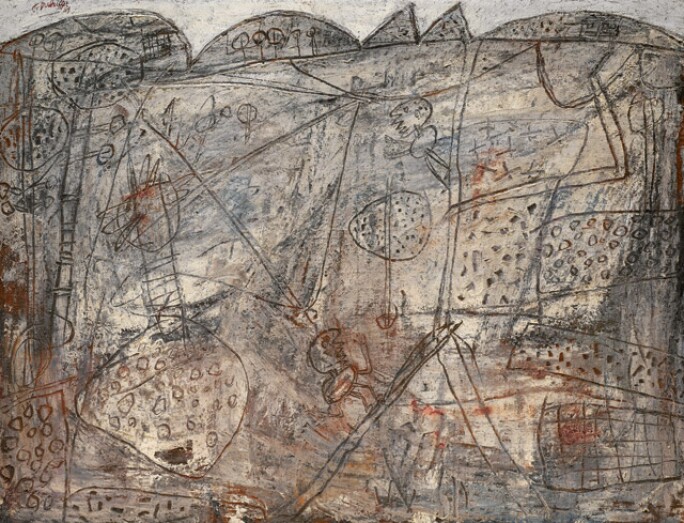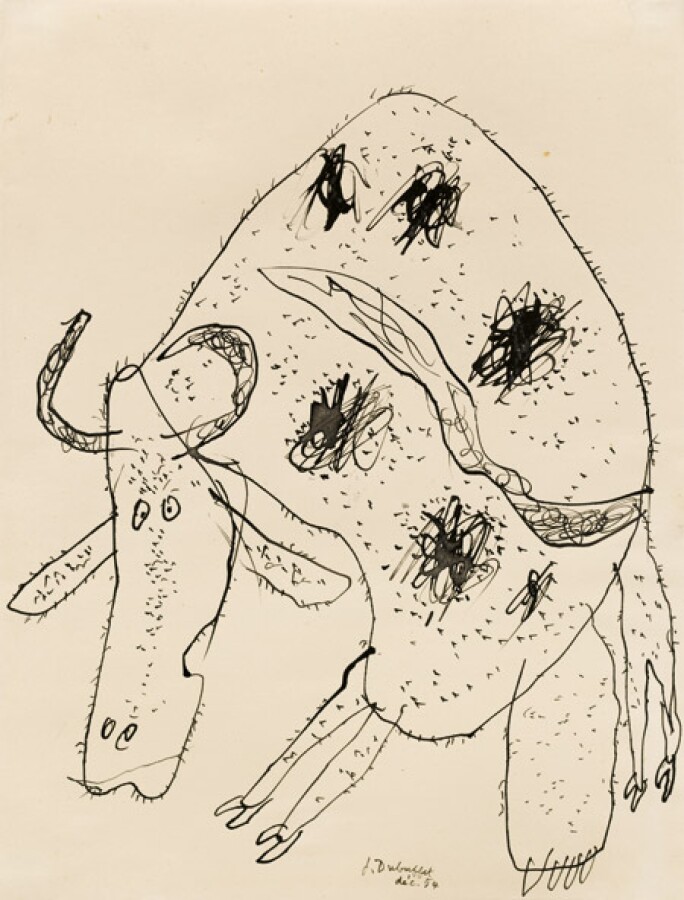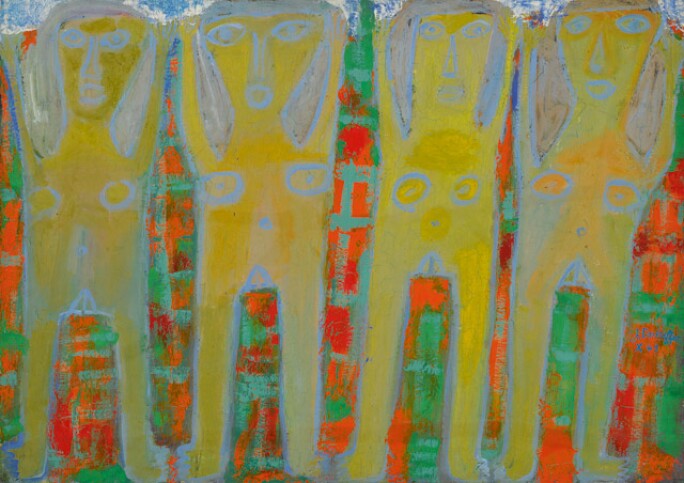As Jean Dubuffet's price index has dramatically increased over the last years, notably thanks to the major international retrospectives held at the Fondation Beyeler in Basel and the Morgan Library in New York (two other retrospectives are being prepared in the Netherlands, including one at the Rijksmuseum) Sotheby's is delighted to present 11 works by the artist in its Contemporary Art Evening Sale and Contemporary Art Day Sale on 6 and 7 June.

JEAN DUBUFFET, PAYSAGE GRIS AUX TACHES CERISES. ESTIMATE €1,500,000–2,000,000.
From Marionnettes de la ville et de la campagne to Corps de Dames and Non-Lieux, to name but a few, Dubuffet’s works are organized around an important number of consecutive series which constitute, every time, a change in style and vision of the world. Like all great artists, Dubuffet subjects his models to the artistic demands of his new series. The traditional genres of painting: the portrait, the representation of the female nude, the landscape or still life, are revisited in each new opus and reinterpreted through the new pictorial language he develops.
In this, Paysages Grotesques not only constitutes a major development in the history of art but also in the revolutionary pictorial techniques of the time as Dubuffet employs an important number of materials in his compositions which are neither bucolic, nor heroic, and far from the romantic ideal. He uses sand, gravel, tar, plaster, coal, stones and asphalt that he boils in a pot and spreads across the canvas with a trowel, a soup spoon, a knife or his fingers thus metamorphosing the countryside, endowing a work such as Paysage gris aux tâches cerises with a rare and singular presence.

JEAN DUBUFFET, VACHE. ESTIMATE €100,000–150,000.
The pictorial matter seems to rise up like fertile earth on the cusp of germination. The paintings hit the gaze, “either by representing a relief, or by living a singular life midway between existence and non-existence, between the real and the imaginary, halfway between belonging to the place objectively represented in the painting or only to the artist’s mental world.” (Jean Dubuffet, Collège de Pataphysique, documentation published by Noel Arnaud). A beautiful lesson on the alchemy of painting. “Portraits and landscapes must come together and it is more or less the same thing, I want portraits where the depiction follows the same mechanism as that of the depiction of a landscape, here ripples and ravines, there a nose, here trees, there a mouth and a house.”
October 1943. The American army liberates Naples, the Germans evacuate Corsica, Italy declares war on Germany and the Red Army march into Ukraine. While the whole of Europe rises up, “the world has [more than ever] a need for new gestures for showing and expressing.” (Max Loreau, Catalogue des travaux de Jean Dubuffet, Fascicule 1 : Marionnette de la ville et de la Campagne). According to Victor Hugo, “the rigorous corollary of a political revolution, is a literary revolution”. For Jean Dubuffet, it is a pictorial revolution. It was urgent to change art, and to take up the paintbrush as other take up their arms.

JEAN DUBUFFET, QUATRE LEVEUSES DE BRAS. ESTIMATE €600,000–800,000.
In the past, Jean Dubuffet gave up twice. The first time was in 1918, at the end of the First World War, when he abandoned his teaching at the Académie Julian after only six months. The second time was in 1936 when, after three months, he preferred to go back to working as a wine dealer which allowed him to live in certain comfort, following in the footsteps of his father.
Seven years later, Jean Dubuffet was ready to embrace the revolution. Not only because “the world has just changed speed” and that some, like Paul Eluard, Jean Fautrier and Jean Paulhan, whom he met in 1943 and would be the first owner of Quatre leveuses de bras, “now feel a growing need to throw themselves into a life that dilates and cracks up everywhere.” (Ibid.) But also because the Dubuffet wine company was now a flourishing affair, counting almost a hundred employees and 40 or so retail branches. Jean Dubuffet felt freed of the “burden of having to make a career out of being an artist”. Rid of “the obsession of having to produce art”, he could now paint for pleasure. It was in this state of mind that a spark was lit at the beginning of 1943. “Jean Dubuffet suddenly saw in his paintings more that he dared to expect” and that he “had been persistently searching for, for over twenty years” the key to all his painting. With a work such as Quatre leveuses de bras, he had found it.
As Max Loreau remarked “prehistory is finished”. Dubuffet would never again put down his paintbrush, drawing upon his imagination and mobilizing his mind because, for him, “art addresses the mind and not the eyes” and if the group of people presented in Quatre leveuses de bras create an almost childlike universe, with its archaic forms and bright, arbitrary colours, there should be no mistake. All Dubuffet’s contribution to the great history of art is resumed here. It is not an unrefined representation of a street bazaar but a mental spectacle nourished by a real philosophical reflection. Here, the maestro questions the representation of the body and the feminine nude in 20th century painting, one of the most sacred genres of Western painting, breaking with the codes of figuration in a totally revolutionary fashion, and revealing a presence. He offers an astounding interpretation through the flattening of forms and the transformation of the body into open planes, outlined by vague and shifting contours. All depth has been abolished. The pictorial space coincides with the surface of the painting, announcing thus the Corps de dames series which so impressed William de Kooning and inspired his Women series.
The message is clear. With Quatre leveuses de bras, the result of over two decades of questioning and research, Dubuffet achieved what has given him so much fame today and why he is celebrated as a genius by art historians: his faculty to create a machine for fabricating the world.




